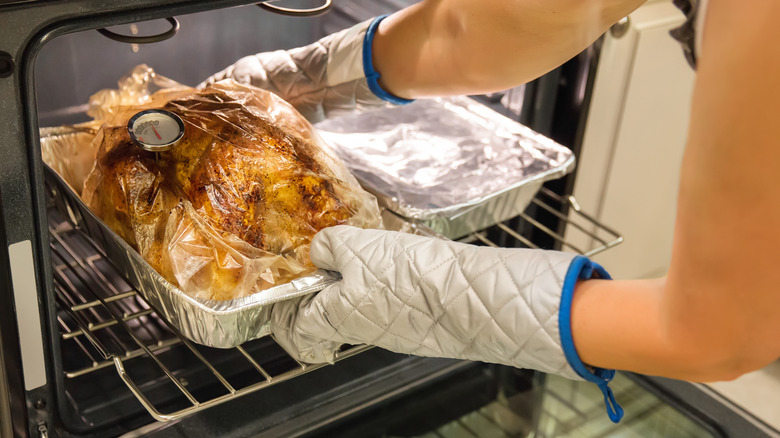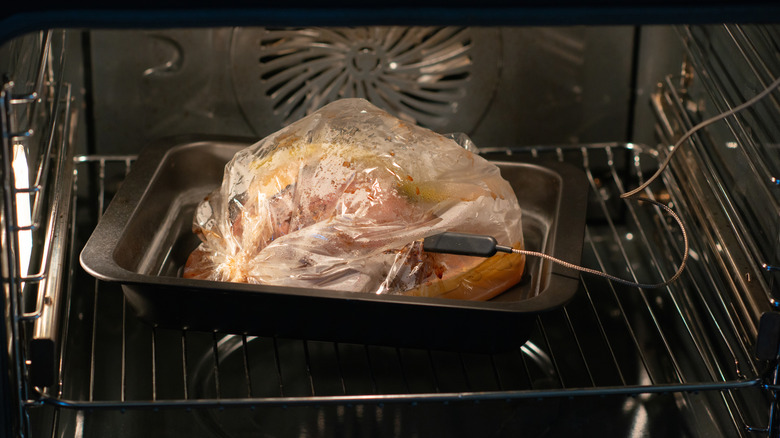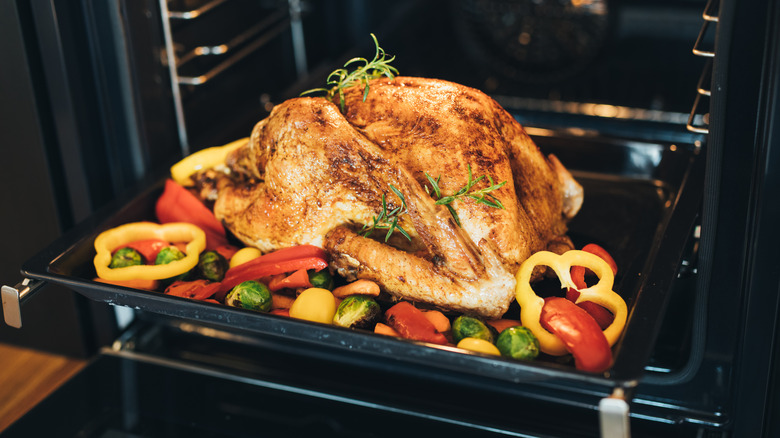How Oven Bags Actually Work And What You Should Cook In Them
Whether it's the holidays, a special occasion, or a weekend family dinner, oven-roasted dishes like roasted Thanksgiving turkey or spiced pineapple ham are go-to picks for preparing a meal for a crowd, but they can present challenges to cook. Luckily, oven bags are catching on as a quick, fuss-free way to guarantee juicy meats.
An oven bag works by creating a sealed environment that captures both heat and humidity inside, thereby expediting the cooking process by circulating steam in a tighter space. Due to their sealed design, an oven bag also automates basting by allowing juices to condensate within its mostly enclosed design. In addition, oven bags maximize the collected juices of its contents while making cleanup amount to merely throwing out the bag.
All of these elements essentially remove the risk of drying a dish out in the oven during the cooking process — especially useful for finicky recipes like oven-roasted poultry. Due to their large size, oven bags should primarily be used for heavy cuts of meat (for example, a whole ham or turkey) that particularly benefit from basting and the retention of their juices.
It's key to follow instructions when using an oven bag
Contrary to some myths that oven bags aren't safe to use, using one will not result in plastic or other toxic compounds seeping into a roast. Brands like Reynolds have been declared FDA compliant for their use of heat-resistant nylon and other approved materials in the products. In addition, food scientists like those with Food Additives and Contaminants have continuously published research showing that most commercial oven bags do not release enough compounds to be considered a health hazard.
Regardless, improperly using oven bags can carry various risks such as burning, melting, or even bursting during the cooking process if you're not careful. To prevent these issues, make sure to line the oven bag with flour to prevent any sticking before placing a roast and its accompanying juices inside. After that, the oven bag should be sealed properly with its accompanying tie, and slits should be cut along its surface to prevent bursting.
In general, most manufacturers recommend that oven bags should only be used in the oven and not broiled unless stated otherwise in the instructions. Also, an external heat thermometer should be inserted through the plastic and into the roast to prevent unnecessarily opening the bag, which could release hot steam prematurely and dangerously. This will not only ensure optimal results for relatively little effort, but could help avoid injuries in the kitchen.
An oven bag isn't ideal if you want crispy results
While oven bags excel in creating a humid bubble between a roast and the oven, they should not be the go-to choice for cooks who prefer a crispy finish to their roasts. Because oven bags circulate and collect juices, similar to steaming, the high humidity within the bag cannot replicate the dry conditions required to crisp turkey skin or the exterior of ham, for example.
That doesn't mean an oven bag works exactly like steaming. While an oven bag cannot produce crispy exteriors, it can allow its contents to brown — albeit not as much as traditional oven roasting. To accommodate for this, cooks recommend removing the contents of an oven bag a little early to finish off via regular roast or better broiling.
This can help create that crispier exterior while retaining the flavor-enhancing benefits of an oven bag, as can putting on a thin layer of oil or butter on the surface of a turkey or ham. However, ditching the oven bag might be the move if a perfectly crisp finish is non-negotiable.



